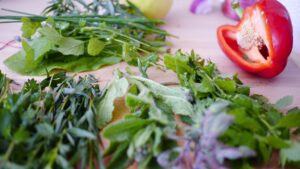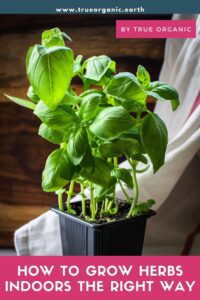March 30, 2022
Growing Herbs Indoors The Right Way
Growing Herbs Indoors The Right Way
The best way to infuse your cooking with the flavor of fresh-picked herbs all year round? Grow your own!
If you’re already caring for houseplants, adding an herb container garden to your indoor plant habitat is a breeze.
Growing herbs indoors is simple and straightforward if you follow a few basic tips. And lucky you, we’re here to dish out all the guidelines — to make sure you’re dishing out zesty flavors, whatever the season.
Best Herbs To Grow Indoors
So many types of herbs are wonderful for indoor container growing. Here are our favorites:
- Basil
- Oregano
- Lemongrass
- Parsley
- Mint (especially spearmint and peppermint)
- Rosemary
- Sage
- Thyme
 Tips For Growing Basil Indoors
Tips For Growing Basil Indoors
Let’s talk about everyone’s favorite: basil. If you’ve tried to grow basil indoors, you might have lost a basil plant or two, likely to insufficient sunlight or poor drainage.
This versatile addition to pasta and salads, with its vivid color and delightful fragrance, can be harder to grow inside than outside. It needs a lot of sunlight!
Basil needs a lot of bright light: at least 6 hours a day minimum. Place it in a sunny location or 6 – 10 inches under grow lights for up to 12 hours a day. Be sure to protect basil from cold-snaps and breezes; it’s very sensitive to cold.
Basil likes to be warmer than other herbs (around 70 – 75 degree Fahrenheit is its preference), so you might need to place your indoor basil plant(s) somewhere toastier than your other herbs.
There are dozens of varieties of basil, some spicy, some sweet, some neon green and some-dark hued. That’s one of the joys of growing basil — choose a variety with a color that you love and a scent that fills your kitchen with joy!
 How To Grow Herbs Indoors
How To Grow Herbs Indoors
Just like any of your indoor green friends, there are a few basic categories of care that you need to pay attention to when growing herbs indoors:
Light
Most herbs need a lot of light. That’s why locating indoors herbariums or container herbs in a windowsill is popular. Just be careful of cold, drafty windows in the winter!
A South-facing window or room is ideal. Choose a location that gets sunlight for 8–10 hours a day, ideally, and at least some direct light.
Of course, in certain places, that can be impossible during the winter! If you live in a low light environment, like a forested area or a Northern latitude, you may want to invest in a grow light for your herbs.
Air Circulation
Good air circulation is one of the most overlooked aspects of indoor plant care. They need good airflow, but don’t want to face strong breezes, either.
Place your herbs somewhere that gets good airflow but isn’t drafty. In winter, this can be challenging, when all your windows are closed and insulated. Place a small fan near, but not too near, your herbs if you’re growing them close together or your home is particularly stuffy. If you have a ceiling fan in a large room with a window, this would also be a good option for sunlight and airflow needs for the plants. Just make sure they’re not getting a direct hit of wind from the fan.
Temperature
Most herbs enjoy a room that is around 65–70 degrees Fahrenheit during the day. Be careful if you live in a cold climate and you turn the heat completely off at night or when you go on vacation in the winter.
Some more hardy herbs, like oregano, thyme, and sage, are fine below 45 degrees, but many herbs will suffer — especially basil, which won’t survive for long below 55 degrees.
Keep herbs, like other leafy housemates, away from radiators, heaters, fireplaces, and heat vents. Their foliage can get dried out or even singed from the heat, and the soil will become too dry too quickly.
Humidity
Just like all other houseplants, indoor herbs need good relative humidity. In winter, soil can dry out quickly, and the inverse can happen in summer. Humidity is closely related to both air temperature and air circulation— so once you set your herbs up in a spot where those two are taken care of, healthy humidity should follow.
Caring For Indoor Herbs
 Containers and Planting
Containers and Planting
Most any moderately, small-sized and well-draining container will be a wonderful home for herbs. You can certainly bring an outdoor container-planted herb plant indoors during the winter! This is a common practice when growing basil because of its sensitivity to cold.
Choose a container for your herbs that is just a bit bigger than your herb’s footprint to allow for room to grow.
A windowsill box or hanging window planter (some of which attach right to the glass, if your window doesn’t have a screen), is a great place for herbs to thrive. They’ll get tons of light, but be careful if the outside air gets very cold. Herbs might be unhappy in the winter if outside air falls below freezing often. For this reason, it’s helpful to have a moveable window box for your herbs if you live in a climate with drastic seasonal changes.
Grouping Herbs
Herbs grow well together; grouping them in the same container can help them stay warm and support good soil drainage. Just be sure that all the herbs you’re planting together require the same watering and light schedule. Research at your local garden store or on your newly purchased plant’s tag or seed package label.
Be aware that some herbs, like basil and parsley, grow quickly and stems can get long and unruly. Luckily, you’ll be using them regularly in your cooking, so pruning won’t take a second thought!
Watering & Drainage
It’s much more common to overwater herbs than under-water them.
A plant mister is an excellent investment for growing indoor herbs. Since their containers can be smaller than other houseplants’, misting herbs rather than watering with a watering can help you avoid accidentally overwatering them.
It’s particularly important that your herbs’ soil is draining well. If soil starts to feel damp all the time, looks greenish, or if bugs start to gather, then repot herbs into a better-draining container. A swarm of gnats around your herbs is a sure sign that you’re either over-watering, or the soil is not draining properly.
Fertilizing Indoor Herbs
You can use a preplant starter, then plant food made for veggies or an all purpose food for your herbs. Fertilize them when they’re growing, during spring and summer. Most herbs are delighted with one feeding every other week, although many can go longer between applications.
Why Grow Indoor Herbs?
Like any other food crop, it can seem like more trouble than it’s worth to grow herbs for culinary purposes. But after you begin, you’ll see how beneficial it is to tend to your own indoor herbs garden.
Growing your own herbs rather than buying them saves money, gives you the opportunity to get creative with new recipes, make fresh teas or broths, and fills your home with the scent of a sunny summer garden.
Plus, the beautiful visual variety of herbs’ foliage is a gift for eyes that ache for greenery in colder winter months. The dark browns of chocolate mint, royal hues of purple basil, and grey-green of sage paint a beautiful plant-scape. Springy chive spikes and texturized mint leaves will begin to give you the same joy as a blooming succulent or a trailing pothos.
Enjoy the smell, view, and flavor!
Show us your True Organic Plants
#GrowWithTrue
www.trueorganic.earth

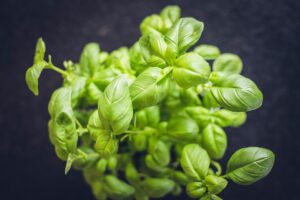 Tips For Growing Basil Indoors
Tips For Growing Basil Indoors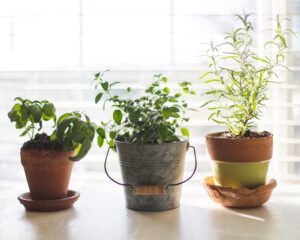 How To Grow Herbs Indoors
How To Grow Herbs Indoors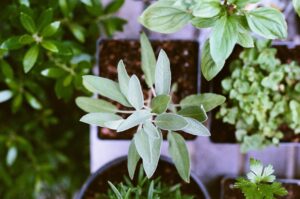 Containers and Planting
Containers and Planting